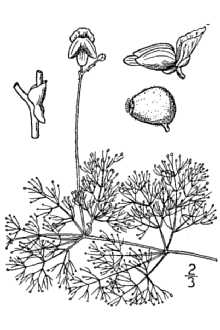Utricularia purpurea
 |
|
Photos Courtesy Renee Brecht |
Britton & Brown |
| Botanical name: | Utricularia purpurea |
| Common name: | purple bladderwort |
| Group: | dicot |
| Family: | Lentibulariaceae |
| Growth type: | forb/herb |
| Duration: | annual, perennial |
| Origin: | native |
| Plant height: | most of plant is submersed, up to 3'; up to 2-6" above water |
| Foliage: | leaves are submersed, and are in whorls of 507 Tiny bladders originally thought to float the plant actually trap and digest very small invertebrates, opening when trigger hairs are disturbed and suddenly sucking in water and any invertebrates (i.e., they are carnivorous). Digestion takes approxiamately 15 minutes to 2 hours. The "bug soup" is then extracted into the stem, clearing out the bladder's vaccuum and resetting the trigger hairs. Mary Treat of Vineland, an early female scientist, did much research on Utricularia and was one of the first scientists to suspect that the bladders were actually traps for tiny creatures rather than air flotation devices. |
| Flower: | 3/8" pink to lavendar |
| Flowering time: | mid July to September |
| Habitat: | aquatic plant of quiet shallow waters |
| Range in New Jersey: | local through the Pine Barrens and outliers |
| Heritage ranking, if any: | S3, LP, HL |
| Distribution: |  |